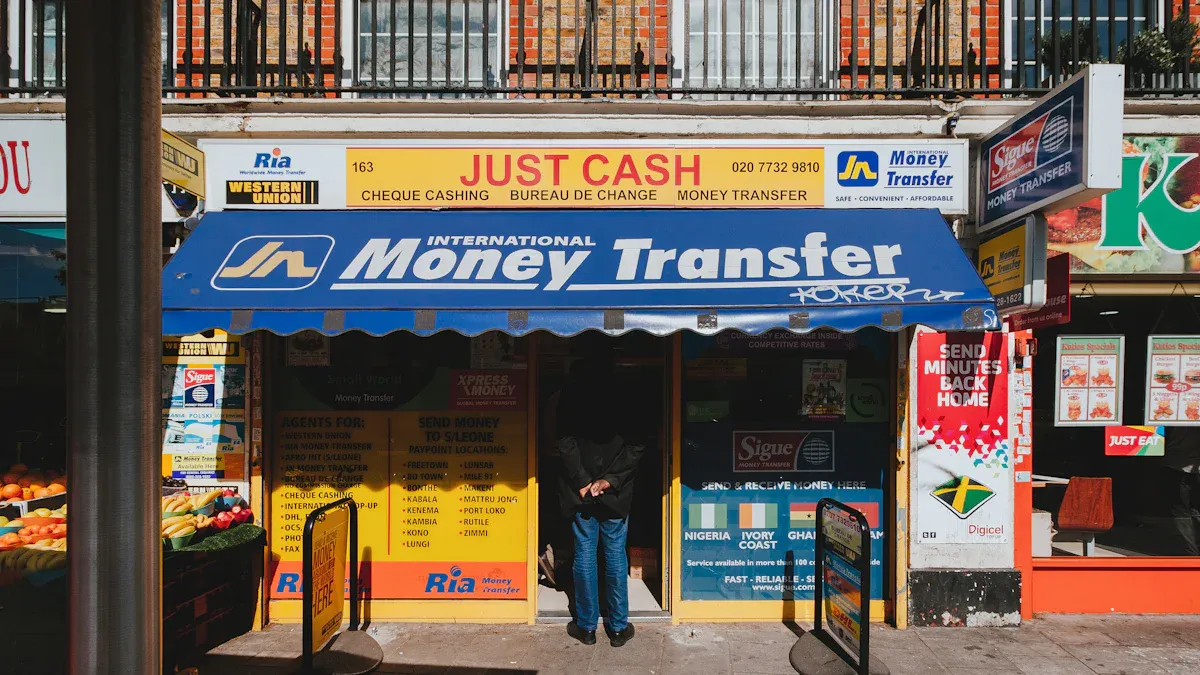- EasyCard
- Trade
- Help
- Announcement
- Academy
- SWIFT Code
- Iban Number
- Referral
- Customer Service
- Blog
- Creator
Real-Time Cross-Border Fund Transfers: Essential Guide for Enterprises in 2025

Image Source: pexels
Entering 2025, the global business environment has placed unprecedented demands on fund efficiency. Your enterprise is facing a critical turning point. Achieving real-time cross-border fund transfers is no longer just a technical upgrade; it is a top-level strategy that integrates policy, technology, and risk control. Global transaction volumes are growing rapidly, and you need to be prepared.
Outlook for 2025
- Experts predict that by the end of 2025, blockchain transactions used solely for cross-border B2B transactions will reach 745 million.
Seizing opportunities means you must re-examine and build a more agile and resilient global fund management framework.
Key Takeaways
- Enterprises need to establish a globally integrated cash pool, which can connect dispersed funds to form a unified central reservoir.
- Enterprises should select appropriate FinTech partners and leverage their payment networks to achieve faster and lower-cost global payments.
- Enterprises should activate the SWIFT gpi payment network, which can accelerate the arrival time of large funds and track the remittance status throughout the process.
- Enterprises should pay attention to digital RMB cross-border payments, which can provide extremely fast speeds and lower costs, simplifying the payment process.
- Enterprises must establish a comprehensive risk control system, which can ensure fund security and comply with constantly changing regulations.
Top-Level Design: Building a Globally Integrated Cash Pool
To achieve instant fund transfers, you must first build a solid underlying architecture. Constructing a globally integrated cash pool is the cornerstone of this strategy. It can connect your “isolated islands” of funds scattered around the world, forming a unified and efficient central reservoir.
Making Good Use of Domestic and Overseas Cash Pool Policies
Policy is the most powerful tool for optimizing your fund management. You need to closely monitor and make good use of the latest regulatory dividends. For example, mainland China is continuously expanding the “domestic and foreign currency integrated cash pool” pilot, which has covered multiple regions such as Jiangsu and Hainan. Shanghai and Chongqing are also actively simplifying cross-border fund transfer processes.
This policy allows your enterprise to integrate funds in mainland China and overseas in a more compliant and efficient manner, achieving free allocation of funds among group member enterprises, greatly reducing internal financing costs and exchange risks.
Of course, while enjoying policy conveniences, you must also pay attention to the regulatory frameworks and tax regulations of various countries, such as transfer pricing and withholding tax issues, to ensure that every operation is legal and compliant.
Establishing Regional Treasury Centers
Establishing a Regional Treasury Center (RTC) is a key step in achieving global fund centralization. You can choose to set up an RTC in international financial centers such as Hong Kong or Singapore, serving as a fund hub for the Asia-Pacific region and even globally.
Leading global enterprises have provided successful examples for this. Sony Group has successfully achieved standardized global fund management and operational automation by establishing three major regional financial centers in Japan, the United States, and the United Kingdom.
Hiroyuki Ishiguro, General Manager of Corporate Finance at Sony Group Headquarters, stated: “I strongly feel that after implementing SAP Treasury, we have enjoyed the benefits of standardized financial operations across regional financial centers. All three major financial centers… use the same financial platform and have achieved very good and stable operations from all angles.”
By establishing an RTC, your enterprise can gain significant advantages:
- Enhanced Fund Visibility: Real-time grasp of global cash positions to make wiser decisions.
- Optimized Fund Allocation: Automatically pool idle funds to quickly respond to subsidiaries’ fund needs.
- Reduced Financial Risks: Centralized management of foreign exchange and interest rate risks, reducing reliance on external financing.
- Improved Operational Efficiency: Simplified bank account management, allowing your finance team to focus on higher-value strategic tasks.
Core Strategies: Multi-Channel Achievement of Real-Time Cross-Border Fund Transfers

Image Source: unsplash
With the top-level design in place, the next step is to choose the right execution path. In 2025, a single payment channel can no longer meet the complex needs of global business. You need to build a diversified payment channel matrix to find the best balance between speed, cost, and security, thereby truly achieving real-time cross-border fund transfers.
Selecting FinTech Payment Partners
Traditional bank wire transfers are being supplemented or even replaced by more efficient and flexible financial technology (FinTech) solutions. Choosing a strong FinTech payment partner is the first step in optimizing your global payment efficiency. These platforms provide faster, lower-cost, and more transparent options than traditional banks through their proprietary payment networks.
When selecting partners, you need to establish a strict set of evaluation criteria. An ideal FinTech partner should possess the following characteristics:
- Compliance and Security: The platform must strictly comply with global anti-money laundering (AML) and know your customer (KYC) regulations, and adopt top-level encryption technology to protect your funds and data security.
- Speed and Coverage: It should have a broad global payment network, support the target markets and currencies required by your business, and achieve near-real-time fund settlement.
- Cost Transparency: You need to clearly understand all transaction fees and foreign exchange rates to avoid hidden costs eroding your profits.
- Technical Integration: The platform should provide modern API interfaces to ensure seamless integration with your existing ERP or financial systems, achieving process automation.
Market Frontier Observation Companies like Airwallex and Nium are shortening cross-border transaction settlement times to real-time through their extensive local payment networks. Companies like Circle and Ripple are using blockchain technology to promote 7x24-hour instant payments.
Among the many options, some emerging platforms provide more comprehensive solutions by integrating multiple technology paths. For example, Biyapay and similar service providers not only build efficient global payment networks but also deeply integrate compliant stablecoin (such as USDC) payment capabilities. This means you can not only conduct traditional fiat remittances but also use stablecoins to achieve near-instant, extremely low-cost value transfers, particularly suitable for e-commerce and SaaS industries that require high-frequency, small-amount payments. Through such platforms, you can easily open multi-currency accounts and conduct receipts and payments in a localized manner, greatly reducing foreign exchange costs and settlement delays.
Activating the SWIFT gpi Payment Network
Although FinTech is developing rapidly, the SWIFT network remains the main artery for global B2B large-amount payments. However, you need to ensure that you are using its upgraded version—SWIFT gpi (Global Payments Innovation). As of now, nearly 60% of SWIFT international transfers are processed through the gpi network, making it an industry standard.
SWIFT gpi solves the biggest pain point of traditional wire transfers for you: uncertainty.
- Lightning-Fast Arrival: It shortens fund arrival time from days to minutes or even seconds.
- Full-Process Tracking: Through the gpi Tracker, you can track the status of each remittance in real time like checking a courier, with the fund location clear at a glance.
- Fee Transparency: You can clearly see the fees at each link in the payment chain, bidding farewell to the past troubles of opaque intermediary bank fees.
- Pre-Validation: Before initiating payment, the system automatically checks the recipient’s account information to detect potential errors in advance, thereby reducing refunds and delays caused by information errors.
Action Recommendation You should immediately confirm with your partner banks (especially banks with rich international business experience such as licensed banks in Hong Kong) whether they fully support SWIFT gpi services. When signing new bank service agreements, make “support for gpi” a mandatory clause to ensure that every large remittance you make can enjoy this speed and transparency.
Deploying Digital RMB Cross-Border Payments
Looking to the future, central bank digital currencies (CBDC) will become a key variable in reshaping the global payment landscape. Among them, China’s digital RMB (e-CNY) and its participation in the mBridge project provide new imagination space for you to achieve real-time cross-border fund transfers.
The mBridge project is jointly initiated by the Bank for International Settlements (BIS) and multiple central banks, and has now entered the minimum viable product (MVP) stage, with Saudi Arabia also joining. It aims to create a universal multilateral CBDC platform to achieve point-to-point cross-border payments.
What does this mean for your enterprise?
- Ultimate Speed and Cost: According to project test data, completing a cross-border transaction through mBridge takes only 7 seconds, while reducing payment costs by up to 50%.
- Simplified Processes: It bypasses complex correspondent bank networks, achieving simultaneous payment and settlement (PvP), greatly improving efficiency and security.
- Higher Transparency: Every transaction is recorded on a shared ledger with extremely high traceability, helping to reduce fraud and financial crime risks.
Of course, the application of digital RMB still faces challenges such as penetration rate and regulatory frameworks. But as a forward-thinking enterprise finance leader, you should start paying attention to its progress now and evaluate how it can be combined with your future supply chain and settlement systems with trade partners (especially in countries along the “Belt and Road”). This is not only a technical attempt but also a strategic layout for the future.
Technology Frontier: AI and Blockchain Reshaping the Future of Payments

Image Source: unsplash
If diversified channels are your current tactical choices, then embracing AI and blockchain is your strategic investment to win the future. By 2025, these technologies are no longer distant concepts but practical tools embedded in daily operations. They will fundamentally change the way you manage and transfer funds.
Embracing AI-Driven Intelligent Clearing
In 2025, you need to regard AI as the “intelligent brain” of the global fund network. It can act like “Waze for funds”, analyzing in real time and selecting the optimal payment path. AI systems dynamically evaluate network queues, foreign exchange liquidity, and transaction fees to find the best clearing solution that balances speed and cost-effectiveness for you.
AI applications are mainly reflected in two levels:
- Efficiency Optimization: AI helps you optimize cash allocation by predicting liquidity needs, reducing idle funds. It can also pre-validate transaction details before payment initiation, reducing delays and failures caused by information errors from the source.
- Intelligent Risk Control: AI can analyze massive transaction data to identify abnormal behavior patterns that traditional rules cannot detect. Platforms like Stripe have reduced certain fraud attacks by 80% with their AI-driven tools, greatly protecting your fund security.
Exploring Blockchain and Compliant Stablecoins
Blockchain technology solves one of the most thorny problems in the traditional financial system for you: business hour restrictions. Taking RippleNet as an example, it uses blockchain networks to achieve 7x24-hour uninterrupted cross-border payments and settlements, allowing your funds to flow instantly even on weekends and holidays.
In practical applications, compliant stablecoins (such as USDC) provide you with a specific path. You can use stablecoins for near-instant, extremely low-cost value transfers, with annual transaction volumes already reaching $5 billion. However, while enjoying the convenience, you must face the new risks it brings.
Risk Alert: Technical Threshold and Compliance Challenges Adopting stablecoins means you must establish entirely new risk control processes. You need to assess the counterparty risks of stablecoin issuers, and establish strict private key management systems, because loss of private keys is equivalent to permanent loss of funds. At the same time, the irreversibility of blockchain transactions requires you to conduct more rigorous verification before payment, which is completely different from the refund mechanism of traditional payments.
Compliance Baseline: Establishing a Full-Cycle Cross-Border Risk Control System
While pursuing speed, compliance is your insurmountable baseline. In 2025, a strong risk control system is no longer a “brake” on business but a “seatbelt” that ensures fund security and efficient flow. You must establish a risk control framework covering the full cycle from account opening to transaction completion, internalizing compliance as a core competitiveness of the enterprise.
From Account Opening Due Diligence to Continuous Monitoring
All risk prevention starts from the source. A sound cross-border payment system is built on a strict customer identity verification process. You need to work with your payment partners to build a solid compliance foundation.
KYC (Know Your Customer) Core Three Steps
- Identity Verification: Confirm the true identity of the transaction counterparty, which is the first step in building trust.
- Customer Due Diligence (CDD): Assess the customer’s risk level. For high-risk customers, you need to perform stricter enhanced due diligence (EDD).
- Continuous Monitoring: Adopt a risk-based approach (RBA), conduct continuous monitoring of high-risk accounts and transactions (such as fund exchanges involving high-risk jurisdictions), and detect anomalies in a timely manner.
This means your risk control system cannot be one-time but a dynamic, continuously optimized process.
Penetrating Identification of Ultimate Beneficial Owners
Regulatory agencies are increasingly focusing on the real controllers behind funds. Penetrating identification of ultimate beneficial owners (Ultimate Beneficial Owner, UBO) has become a core requirement for global anti-money laundering. You must ensure that you can clearly identify the individual who ultimately owns or controls more than 25% of the equity behind the entity you are transacting with.
Identifying complex company equity structures is a daunting task. Fortunately, technology is simplifying this process. Modern regulatory technology (RegTech) platforms use artificial intelligence and automation technology to:
- Automatically extract and cross-verify UBO information from global databases.
- Reveal hidden ownership relationships by analyzing complex equity networks.
- Seamlessly integrate KYB (Know Your Business) with KYC processes, greatly improving the efficiency and accuracy of verification.
Responding to New Regulations on Cross-Border Remittance Reviews
The global regulatory environment is tightening, with increasing demands for information transparency. You must closely monitor and adapt to two key changes:
- FATF "Travel Rule": This rule requires you to transmit the detailed information of the remitter and the recipient along with the transaction when processing cross-border transfers exceeding $1,000. This applies not only to traditional wire transfers but also to crypto asset transfers.
- ISO 20022 Standard: The global payment system is migrating to this new message standard. It requires you to provide richer and more structured data in payment instructions, such as complete address information. This not only improves the automation of payment processing but also makes regulatory screening more accurate.
Action Guide You should immediately communicate with your banks and payment partners to ensure that their systems can support and meet the requirements of the “Travel Rule” and ISO 20022 standards. This can help you avoid transaction delays or failures caused by incomplete information.
In 2025, achieving real-time cross-border fund transfers requires you to adopt an integrated strategy. This strategy requires you to: prioritize top-level design, use multiple channels in parallel, explore cutting-edge technologies, and have compliance risk control as a solid backing.
Act Now As an enterprise finance leader, now is the best time to act. You should immediately assess your existing fund management architecture, seize the policy window period, and start researching new solutions. Winning the future fund efficiency advantage will allow you to remain invincible in competition and ultimately achieve efficient real-time cross-border fund transfers.
FAQ
I am an SME; are these strategies too complex?
You do not need to implement all strategies at once. You can start by choosing an appropriate FinTech payment partner. Many platforms provide flexible, low-cost solutions for SMEs to help you optimize cash flow.
Which cross-border payment method has the lowest cost?
For small-amount high-frequency transactions, FinTech platforms and compliant stablecoins usually have lower costs. For large-amount payments, activating the bank’s SWIFT gpi service can improve efficiency and clarify fees. You need to use them in combination according to specific needs.
Do using AI and blockchain require a large IT team?
You do not. Modern payment platforms have encapsulated AI and blockchain technologies into easy-to-use services. You can seamlessly integrate them into existing systems through API interfaces without deep technical background.
How to keep up with constantly changing regulations such as the FATF “Travel Rule”?
You should maintain communication with your payment partners and banks (especially experienced licensed banks in Hong Kong). They are obligated to comply with the latest regulations, such as the “Travel Rule” requiring the transmission of information for transfers exceeding $1,000.
Where should I start?
The first step is to assess your current fund management architecture.
- Analysis: Sort out your global bank accounts and cash flows.
- Communication: Confirm with your bank whether it supports SWIFT gpi.
- Research: Start researching one or two reputable FinTech payment partners.
*This article is provided for general information purposes and does not constitute legal, tax or other professional advice from BiyaPay or its subsidiaries and its affiliates, and it is not intended as a substitute for obtaining advice from a financial advisor or any other professional.
We make no representations, warranties or warranties, express or implied, as to the accuracy, completeness or timeliness of the contents of this publication.




Contact Us
Company and Team
BiyaPay Products
Customer Services
BIYA GLOBAL LLC is a licensed entity registered with the U.S. Securities and Exchange Commission (SEC No.: 802-127417); a certified member of the Financial Industry Regulatory Authority (FINRA) (Central Registration Depository CRD No.: 325027); regulated by the Financial Industry Regulatory Authority (FINRA) and the U.S. Securities and Exchange Commission (SEC).
BIYA GLOBAL LLC is registered with the Financial Crimes Enforcement Network (FinCEN), an agency under the U.S. Department of the Treasury, as a Money Services Business (MSB), with registration number 31000218637349, and regulated by the Financial Crimes Enforcement Network (FinCEN).
BIYA GLOBAL LIMITED is a registered Financial Service Provider (FSP) in New Zealand, with registration number FSP1007221, and is also a registered member of the Financial Services Complaints Limited (FSCL), an independent dispute resolution scheme in New Zealand.




















